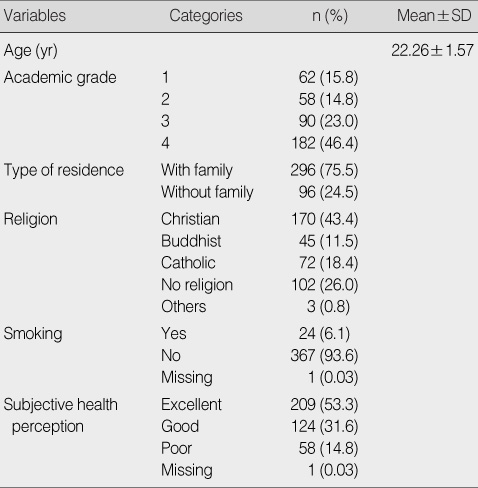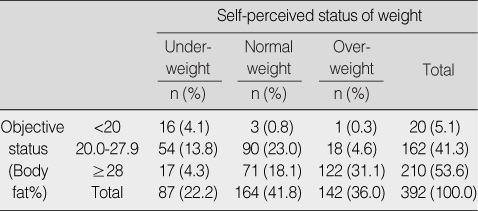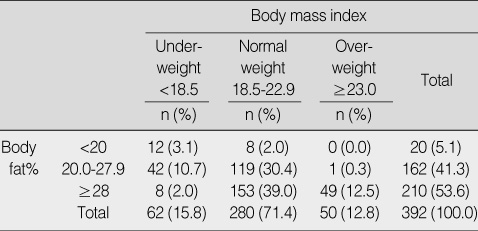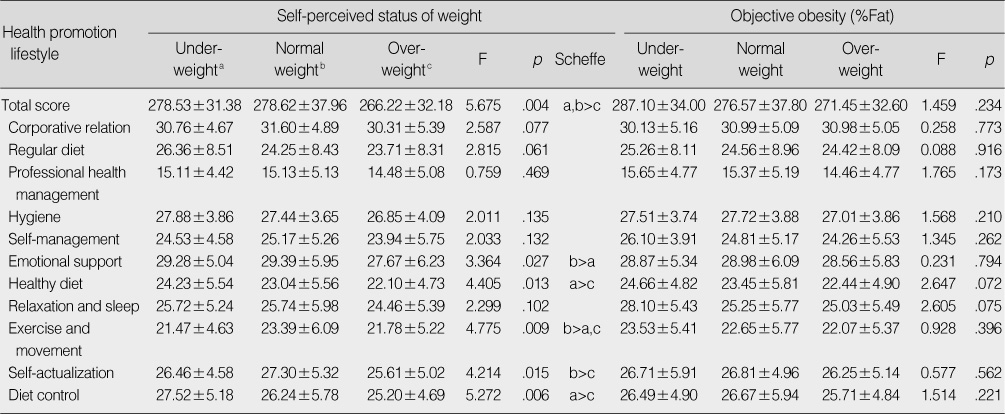Articles
- Page Path
- HOME > J Korean Acad Nurs > Volume 39(5); 2009 > Article
-
Original Article
- Health Promotion Lifestyle According to Self-Perception of Obesity and Objective Status Measured by Bioelectric Impedance Analysis in College Women
-
Eun Young Chang, Jeong Sun Kim, Su Jin Shin

-
Journal of Korean Academy of Nursing 2009;39(5):693-699.
DOI: https://doi.org/10.4040/jkan.2009.39.5.693
Published online: October 31, 2009
1Research Professor, College of Medicine, Sungkyunkwan University, Suwon, Korea.
2Assistant Professor, College of Nursing, Chonam National University, Gwangju, Korea.
3Assistant Professor, Department of Nursing, Soon Chun Hyang University, Cheonan, Korea.
- Address reprint requests to: Shin, Su Jin. Department of Nursing, Soon Chun Hyang University, 366-1 Ssangyong-dong, Cheonan 330-090, Korea. Tel: 82-41-570-2491, Fax: 82-41-575-9347, ssj1119@sch.ac.kr
• Received: March 2, 2009 • Accepted: September 18, 2009
Copyright © 2009 Korean Society of Nursing Science
Figure & Data
REFERENCES
Citations
Citations to this article as recorded by 

- Association between obesity type and dyslipidemia by age and sex: a cross-sectional study using data from the 2022 Korea National Health and Nutrition Examination Survey
Eun-Hye Lee, Yun-Hee Kim
Journal of Korean Biological Nursing Science.2025; 27(2): 169. CrossRef - A secondary analysis examining the concordance of self-perception of weight and actual measurement of body fat percentage: The CRONICAS Cohort Study
Anthony L. Bui, Miguel G. Moscoso, Antonio Bernabe-Ortiz, William Checkley, Robert H. Gilman, Liam Smeeth, J. Jaime Miranda
BMC Obesity.2019;[Epub] CrossRef - Comparison of Health Promoting Lifestyle and Self-Efficacy in Female Students with and Without Primary Dysmenorrhea
Somayyeh Naghizadeh, Maryam Ebrahimpour maleki, Golsa Patras, Maryam Jafari
ranian Journal of Health Education and Health Promotion.2019; 7(3): 285. CrossRef - Body Weight Control Behavior and Obesity Stress of College Women
Yang-Hee Kang, Kyung-Hee Kim
The Journal of the Korea Contents Association.2015; 15(2): 292. CrossRef - Associations between Weight Control Behavior and Health Behaviors in Korean Young Women: 2013 Community Health Survey
Jae-Hee Kim
Journal of the Korea Academia-Industrial cooperation Society.2015; 16(7): 4734. CrossRef - Development of Health Dieting Competency Scale for College Students
Jeongsoo Kim, Yumi Lee
Korean Journal of Adult Nursing.2014; 26(3): 300. CrossRef - Health Promotion Behavior according to Body Mass Index and Self-Perception of Body Weight in Female Nursing Students
Su Jeung Yu, Kyung-Sook Lee, Joo Hyun Kim, Kyung Choon Lim, Jin Sook Park
Journal of Korean Biological Nursing Science.2014; 16(1): 60. CrossRef - Experiences of Health Related Lifestyles in High Body Fat but Non-obese Female College Students in Korea
Jeongsoo Kim
Osong Public Health and Research Perspectives.2014; 5(1): 68. CrossRef - Effect of Body Composition and Osteoporosis Self-efficacy on Bone Mineral Density of Female Nursing Students
Kyu Eun Lee, Nam Sun Kim
Journal of Korean Academy of Fundamentals of Nursing.2013; 20(3): 230. CrossRef - Body Composition, Blood Pressure, Blood Lipids, and Glucose according to Obesity Degree by Body Fat Percentage in Female University Students
Eun Hee Jang, Young Rye Park
Journal of Korean Biological Nursing Science.2012; 14(4): 231. CrossRef - Self-reported Realities of Health Behavior of Undergraduate Students After Web-based Health Promotion Education: Qualitative Content Analysis
Joo Hyun Kim, Eun Young Park, Kyung Choon Lim
The Journal of Korean Academic Society of Nursing Education.2012; 18(3): 413. CrossRef - The Process of Female University Students' Experiences in Healthy Dieting
Jeong-Soo Kim
Journal of Korean Academy of Community Health Nursing.2012; 23(3): 244. CrossRef - A Study of Body Composition, Dietary Behavior, and Exercise among Students at Women's Colleges
Ji-Yon Eom, Duk-Yoo Jung
Journal of Korean Public Health Nursing.2012; 26(1): 28. CrossRef - Weight control behavior in women college students and factors influencing behavior
Hyun-Young Yang, Young-Soon Byeon
Journal of Korean Academy of Fundamentals of Nursing.2012; 19(2): 190. CrossRef - Bone Mineral Density, Body Mass Index, Stress, and Health Promotion Lifestyle of Female College Students
Chunmi Kim, Eun Man Kim
Journal of Korean Academy of Community Health Nursing.2010; 21(3): 333. CrossRef
Health Promotion Lifestyle According to Self-Perception of Obesity and Objective Status Measured by Bioelectric Impedance Analysis in College Women
Health Promotion Lifestyle According to Self-Perception of Obesity and Objective Status Measured by Bioelectric Impedance Analysis in College Women
General Characteristics of Participants (N=392)
Comparison of Self-perceived Status of Weight with Objective Status
kappa=0.329.
Comparison of Body Mass Index with Body Fat
kappa=0.139.
Health Promotion Lifestyle by Self-perceived Status of Weight and Objective Obesity
Table 1
General Characteristics of Participants (N=392)
Table 2
Comparison of Self-perceived Status of Weight with Objective Status
Table 3
Comparison of Body Mass Index with Body Fat
Table 4
Health Promotion Lifestyle by Self-perceived Status of Weight and Objective Obesity
 KSNS
KSNS
 E-SUBMISSION
E-SUBMISSION




 Cite
Cite

